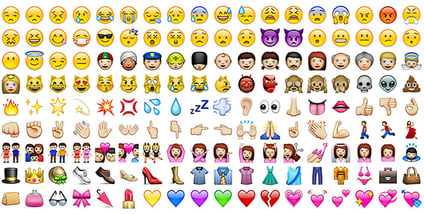 Parlez-vous emoji? Step aside, French – there’s a new language of the future. Well, maybe.
Parlez-vous emoji? Step aside, French – there’s a new language of the future. Well, maybe.
Since Apple’s release of the emoji keyboard in 2011, the use of emojis has grown exponentially. This past March, nearly half of Instagram comments and captions contained emoji characters. But this isn’t just the language of choice for consumers. Emojis are brands’ latest attempt to appeal to the younger, texting-heavy demographics of Millennials and Gen Z. Brands such as Coca-Cola and Bud Light are using emojis to create unique content to stand out with these younger demographics. Even though these tiny images can set a brand’s message apart, it’s also very easy for the message to fall flat with consumers.Even so, brands are venturing into the world of emojis to develop content as well as to investigate their audiences. Independent shop Big Spaceship is working on technology to develop definitions for brand tracking via emojis. This would be done similar to the measurement of brand sentiment using the occurrence of specific words on social media. The idea isn’t to look at emojis alone, but to examine them within the context of social content. Theoretically, this would allow brands to examine differences as seemingly miniscule as using a red heart instead of a blue heart in a social media comment.
Instagram considered this very difference in their Emojineering blog, and found that, in fact, blue hearts and red hearts don’t mean the same thing. Instagram took a similar approach to Big Spaceship and studied the occurrence of specific emojis with specific words and hashtags. They examined the hashtags associated with certain color hearts in the absence of a red heart. A blue heart lead to Duke-related hashtags (#goblue, #letsgoduke, etc.) and Autism Awareness-related hashtags (#autismspeaks), while a yellow heart lead to spring-related and earth-related hashtags (#springhassprung, #hellospring, #happyearthday, etc.).
As a market researcher, this use of emojis is intriguing and problematic. I’d love to know the meaning and reasoning behind a consumer’s decision to post a cat emoji rather than the kitten face emoji, but playing Bletchley Park doesn’t necessarily mean I’ll find what I’m looking for. The texting-based language of emojis, while expressive, only brings us a little bit closer to the full picture. There is a much easier way to get an honest read of respondents’ emotions towards a brand—just ask them. At CMB, we use custom market research and our new survey-based approach to measuring the emotional impact of brands, EMPACT℠, to find out how your customers really feel about your brand. . .rather than spend time defining heart and cat emojis.
Blair Bailey is an Associate Researcher at CMB who ![]() .
.



 Sitting in my cozy Boston office, sipping coffee, I’m suddenly transported to Washington State’s Cascade Mountain Range, soaring above the mile-high Cowboy Mountain and scanning Tunnel Creek, a popular, snow-powdered trail and the site of the tragic 2012 Stevens Pass avalanche.This is the genius of the graphics that accompany “
Sitting in my cozy Boston office, sipping coffee, I’m suddenly transported to Washington State’s Cascade Mountain Range, soaring above the mile-high Cowboy Mountain and scanning Tunnel Creek, a popular, snow-powdered trail and the site of the tragic 2012 Stevens Pass avalanche.This is the genius of the graphics that accompany “